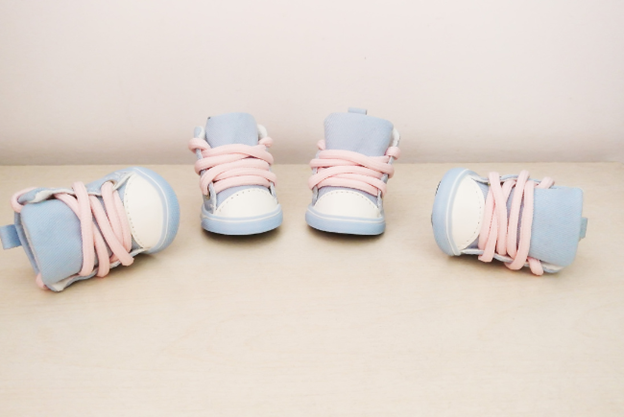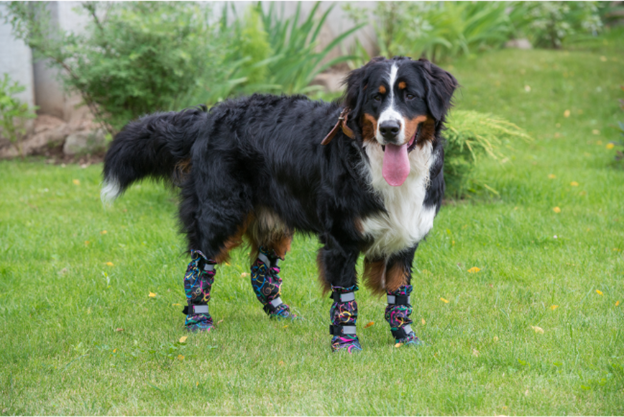Training Your Dog to Wear Shoes: Tips and Tricks

Some dogs have tough paw pads for hiking over all outdoor terrain, but others need added foot protection so you can take them to more places without injuring their paws. Dog shoes help prevent cuts, burns or irritation on sensitive paw pads.
Covered paws also stay cleaner indoors after muddy or snowy walks. And shoes with rubber grips give better winter traction, avoiding slips on icy sidewalks. Lastly, dog shoes are cute, letting pets show off their trendy looks and personalities when out and about town!
1. Enhanced Paw Pad Shielding
Rugged, sharp, or rocky ground can cause paws to get scraped or sensitive skin to burn in the summer heat. Tough shoe bottoms add a helpful buffer layer, defending tender feet from harm when exploring rough nature trails with owners happily.
2. Improved Outdoor Hygiene & Indoor Cleanliness
Covered feet bring back less dirt and mud, getting floors messy at home after walking through the park, fields or trails on rainy days. No more soaked, messy paws leaving a wet trail where they walk, either!
3. Better Traction and Stability
Rubber tread shoe bottoms grip better on packed snow days, preventing scary slips and falls along icy, hard sidewalks throughout the neighborhood on winter walks, improving safety.
4. Fun Canine Fashion Styling Opportunities
Beyond just functional purposes, doggie shoes now come decorated with cute patterns, fabric choices, and even blinking LED lights. This allows pets to show off signature looks coordinating with seasonal outfits for extra tail wags and ear scratches approvingly from smiling strangers passing by. Go creative with matching shoes and collar combos to your pup’s playful personality delightfully.
5. Picking the Ideal Pairs of Dog Shoes
When beginning introductory training, getting paws used to wearing new shoes, start off setting dogs up for success by picking correctly fitting footwear and making comfy first impressions:

a) Ensure Correct Sizing
Shoes too big simply fall off, while too-tight ones irritate terribly. Measure paw widths and lengths precisely so chosen pairs match as perfectly as possible depending on sizing charts for the exact doggie shoe brand and style you select, coordinating activities done.
b) Maximize Comfort First Always
Avoid stiff boot materials, uneven seams, or annoying heel straps. Choose flexible, soft fabrics, cuddling paws like cozy socks optimally over longer initial periods until pups grow, and accept incrementally through positive reinforcements.
c) Focus on Durability Second
Since curious canines will inevitably scamper through brush or jump into puddles needing washing shortly after, pick rugged shoe materials that are puncture/cut-resistant and easily washable so they withstand regular puppy adventures lasting maximally.
d) Account for Weather Conditions
Choose lighter, breathable boots for dogs for hot summer hiking and insulated, waterproof boots trekking through soggy fields come winter walking seasons ahead year-round, protecting paws appropriately as outdoor elements vary.
6. Train Dogs Patiently to Accept Wearing Shoes
Once securing the perfect starter pairs, introduce shoes using approaches avoiding overwhelms so pups feel less bothered and remain cooperative:
a) Shower Pups with Praise and Treats for Attempts
From the first few seconds, shoes touch paws, clap and happily reward smaller time milestone triumphs enthusiastically with yummy snacks, creating positive feelings around the gradual paw-wearing process ahead together.
b) Build Up Wearing Time Slowly Day By Day
Rather than wrestling shoes on reluctantly beyond a pup’s comfort tolerance, capture even 30-second wins to start slowly extending into minutes across days and weeks using patience and compassion, never forcefully critically. Celebrate little steps on the journey literally!
c) Allow Home Practice Opportunities First
Letting dogs first try wearing shoes briefly around the home helps them acclimate. Predicting outdoor usefulness by seeing boots helps them navigate slick floors or clean easily after playing in the backyard mud puddles. Early successes build outdoor-wearing confidence gradually.
7. Troubleshooting Pup Struggles with Shoes
While most pups are growing accustomed to shoes just fine, here are tactics for overcoming potential hiccups:
a) Keep Early Shoe Exposure Sessions Short
Quit all initial attempts on the highest notes before puppy patience wears thin. Avoid nibbling or intensive pawing interference. Even brief victories, such as wearing shoes and then immediately treating, keep positive progress moving forward.
b) Experiment with Different Style and Size Options
If specific shoe selections irritate continually when worn – try diagnosing issues by switching adjustable straps, texture fabrics, colors or updated precise sizing specs, eliminating improper fits impeding tolerability and training advances desired.
c) Ask Trainers for Customized Help Tailored to Your Dog
Should progress plateaus temporarily despite enthusiastic praise and style switches, consult professional animal behaviorists specializing in canine training, identify addressable obstacles, and provide personalized tactics targeting successful shoe-wearing permanently.
8. Added Tips Helping Dogs Love Wearing Shoes
Here are a few more pointers for your pup to master shoes:
a) Introduce Shoes Young Early On
Helping young puppy paws grow used to light booties sets them up happily accepting shoeing requests effortlessly as routine adults already when asked to protect tender feet initially.
b) Commit to Consistent Patient Practice
Some newly rescued apprehensive pets require even more loving coaxing through fearful barriers currently mentally. However, given compassion plus time, even uncertain pups ultimately succeed, so they remain consistently nurturing progress but gradually appear temporarily.
c) Consider Protective Seasonal Dog Outerwear, Too!
Since pups readily accept occasional wardrobe additions like winter coats or rain slickers for harsh elements protection, make seasonal booties, weatherproof jackets and reflective outerwear regulars assisting safeguarding precautions better as responsible pet parents devoted to dogs entirely.
Conclusion
When introduced positively, including proper sizes slowly and praise rewards given amply, most pups accept light booties, ultimately stepping lively beside barefoot four-legged friends unfazed on walks. Starting shoeing early acclimates tender-footed dogs to coverings and protecting delicate paw pads more responsibly.
Practice persistent patience, rewarding small steps until both run free together confidently in comfort and safety persistently for optimal health – no matter the seasonal terrain faced fearlessly cheek to cheek year-round lives better booted ultimately!
